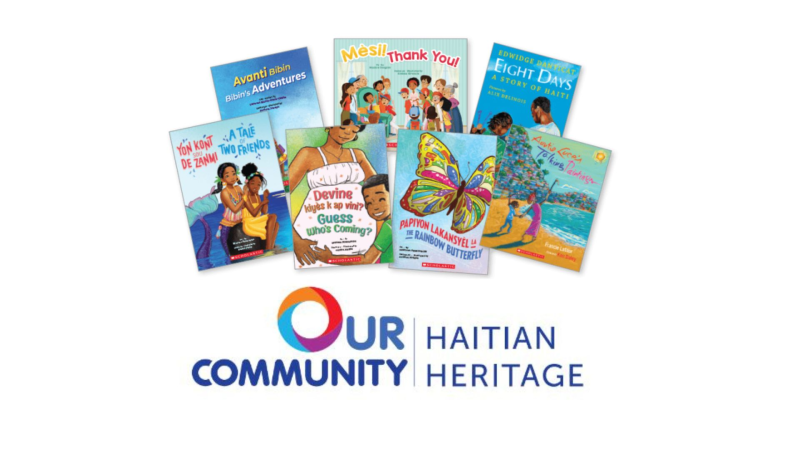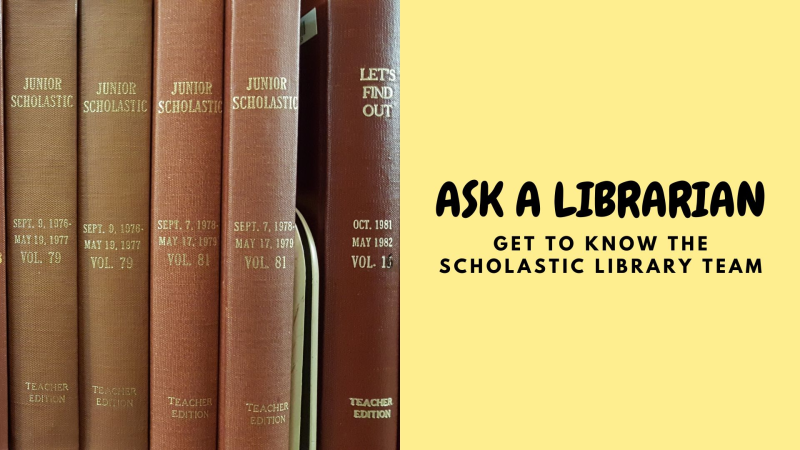 Now that 2016 has come to a close, we chatted with eight outstanding librarians to get their takes on what trends will have a meaningful impact on the education field in the new year. From going paperless district-wide, trying silent conversations in the classroom, and implementing virtual reality, to learning programming languages and focusing on students’ social and emotional learning, one thing is for sure—it’s going to be an exciting year of creative learning and promoting the inspirational work happening in libraries and schools across the country every single day! Check out the librarians’ full responses below.
Now that 2016 has come to a close, we chatted with eight outstanding librarians to get their takes on what trends will have a meaningful impact on the education field in the new year. From going paperless district-wide, trying silent conversations in the classroom, and implementing virtual reality, to learning programming languages and focusing on students’ social and emotional learning, one thing is for sure—it’s going to be an exciting year of creative learning and promoting the inspirational work happening in libraries and schools across the country every single day! Check out the librarians’ full responses below.
Happy new year everyone!
Kristina Holzweiss (@lieberrian) – Providing Opportunities for Empowerment
2015 School Library Journal School Librarian of the Year, Bay Shore Middle School, Bay Shore, NY
What I believe is on trend for school libraries is also happening in classrooms across America—providing opportunities for empowerment where our students can speak their minds and develop their own voice transcends content and assessment. It is not so much what toys and tools that are in our makerspaces, the books that are on the shelves, or the databases that they can access from home or at school; it is how our students can use these resources to learn about their neighbors around the world. With social media and communication technologies such as Skype, Google Hangouts, and Flipgrid, our students are becoming global citizens more easily than ever. When we empower our students to take ownership of their learning, they are transformed from patrons to members of a learning community.
Julie Greller (@cybrarian77) – The Paperless Library
Education Media Specialist, Ridgefield Park Junior/Senior High School, NJ
The trend is not what is happening in libraries, the trend is what is happening in our students. Our students are the future leaders and solving problems that we have never dreamed before. We need to support them so they can develop communication, collaboration, cooperation, and creative problem solving skills so that they can participate in a culture of understanding and respect. We need to support our students to be not only college and career ready, but life ready.
Even though it took my school district close to 4 years to adopt Google Apps for Education, I’m sure they’ve saved a lot of money and trees by utilizing the paperless classroom. The cloud has become the place to create, share, and grade files. Students working in the school library have the added convenience of apps, extensions, and online bibliography makers to ease their workload. Although there will always be teachers who want their students to print out their papers, I see school budgets putting the brakes on, and more paperless options down the road. As for the future of the printed page, I’m sure books will be around a lot longer than we thought. Kindles cost more than many districts can afford, and school libraries need to keep them in working condition (I lived through a budget of zero dollars, and I assure you e-readers were not a priority). What else is on the horizon for school librarians? Smaller budgets, for sure.
Todd Burleson (@todd_burleson) – Makerspace Technology
2016 School Library Journal School Librarian of the Year, Hubbard Woods School, Winnetka, IL
My predictions for things that will make a large difference in education in 2017:
- Virtual reality: The technology behind VR has been making a logarithmic improvement. Google Expeditions can transport students anywhere in the world via VR headsets. They have built a platform that allows teachers to manage virtual field trips and after downloading to the teacher tablet, the expeditions can be taken entirely free of Wi-Fi or the Internet.
- 3D printing: Over the last year, I've had the chance to explore 3D printing with a variety of 3D printers and software. I believe that the hardware is finally at the point where we can consistently print projects reliably and efficiently. In my experience, Ultimaker is the superior 3D printer. Their newest printer has a dual extruder that can print in multiple colors or print support materials in water dissolvable filament. Along with the improved hardware, the software that allows students to design actual models has improved as well. My favorite app for 3D design with students is Morphiapp.
- Prototyping: One of the most powerful components of 'making' in our makerspace is prototyping solutions. We believe that having students develop prototypes to real problems allows them to see themselves as change makers. We survey our students and teachers to find real problems and work to develop solutions to them. We use tools like Rigamajig to prototype life-size solutions to problems.
Anita Cellucci (@anitacellucci) – Focus on Emotional and Mental Health
2016 School Library Journal School Librarian of the Year Finalist, Westborough High School, Westborough, MA
Hope, truth, and positive voice are all coming to light as important to the emotional and academic growth of our students in our world today. Thinking about these topics in relation to emotional and mental health for teens, libraries and educators will be looking for creative ways to weave current topics and opportunities into curriculum and the learning space to offer to students. Here are my predictions of things to watch for:
- Forum discussions as a way to allow students to voice their concerns, feelings, and questions about their lives, to promote diversity and a way to unify and create community. I expect to see student lead initiatives at the high school level and teacher driven curriculum at the elementary/middle levels.
- Storytelling revamped through community collaborations of libraries and telling our truth through our heritage, culture and diversity. As this topic is central to the mission of libraries, I expect to see an influx of new ideas to showcase the stories in communities and schools.
- Social emotional learning as way to promote positive voice and awareness of self, empathy, and cultural understanding. As ESSA is focused on this as well, it will become a necessary topic of discussion for educators in all grade levels but a new found focus in high school as according to the National Alliance on Mental Illness, 30% of youth live with a mental health condition.
- Inquiry based instruction as a way to allow students to be curious about their role in our democratic society. Teaching through inquiry allows the educator to facilitate learning through an essential question while students delve.
Michelle Colte (@Michelle_Colte) – Learning-on-Demand
2014 School Library Journal School Librarian of the Year, Hale Kula Elementary School, Wahiawa, HI
Author, composer, and songwriter Eric Ode performed at our school and as he gazed around the library, he commented, “I loved getting lost in the library as a kid.” I nodded in agreement because this too, is what I love about libraries but I’m not sure that my students have this same opportunity. During the school day, bell-to-bell instruction, assessments, and the pressures of standardized testing have negated time for students to learn through playful discovery. While I create time for playful discovery in makerspace activities, I frequently find myself rushing students to make quick borrowing choices after my teacher-directed, one-size-fits-all library lessons. Prompted by Ode’s reminder, I’ve stopped teacher-directed lessons and created the opportunity for students to direct their own “learning-on-demand.”
Looking ahead, my trend predictions for 2017 are:
- Connecting with books: Kids sit shoulder to shoulder, nestled into pillows reading. Occasionally, one nudges the other and points to something on the page, sharing a smile over their discovery. Some students choose to read by themselves. Others like to stretch out on the window benches next to stuffed animals.
- Silent conversations: I borrowed this idea from my librarian friend, Debby Vandersande. She puts copies of the state award contenders on tables with chart paper and pens. Each paper asks a question, shares a quote, or invites students to respond to a prompt related to the book. Students respond to the books/prompts that they’ve read or that interest them. Debby then leaves the charts out for other classes/students to discover.
- Students teaching students: The other day, a 5th grader helped a new student find the most recent James Patterson book in the fiction section, explaining the books are organized by the author’s last name.
- Remembering school-wide events: Students love to look at photos of themselves and their families from The Big Draw, The Cardboard Challenge, or Dot Day.
- Seeking opportunities: Students jump off of our library website to visit our makerspace Instagram page to see the latest posts. They might sign up to lead their own lunch-time pop-up or post a response on our blog.
- Building and creating: Whether it’s the hexagon tiles, magnetic art, PVC pipes, or paper roller coaster, students love to manipulate and construct. Teachers lean in to see what their kids are creating and frequently contribute to a collaborative build.
- Developing perseverance: A student wanted a book about Fennec Foxes, but the one copy we had was being used for research. I suggested she find another animal book and directed her to the 599s to find books about other foxes. She protested, “I don’t want a book about other foxes, I want a book about Fennec Foxes!” and stormed off. A few minutes later she rushed to the circulation desk, flung back the cover of the Mammals book, turned to a page in this inch thick book and pointed to a page on the Fennec Fox, “I found it!” She beamed.
Sally Smollar (@smollas) – Coding Education
2015 School Library Journal School Librarian of the Year Finalist, Plumosa School of the Arts, Delray Beach, FL
Back in the early days, learning programming languages such as Fortran, Perl, or Basic required intense years of study and high levels of math and science backgrounds. Over the years the technology of human-machine languages evolved until the invention of JavaScript enabled the skill to be accessible to anyone with a desire to learn. Now, that has changed and the library can be the change agent that introduces coding to patrons of all ages, even pre-schoolers!
Websites such as Code.org, Code Combat, and Google CS First are making coding not only easy to learn but tremendously entertaining. Using characters from well-known themes that include Elsa and Anna, Star Wars, and Minecraft, users can spend hours developing skills that will be in great demand in the workforce. December 5–11 kicks off this year's Computer Science Education Week and mini sessions are available on the Hour of Code website, but the resources are available all year long, so any time is the right time to begin. Facilitators need no knowledge of programming or computer science whatsoever and might even find themselves logging some hours coding along with their patrons! For more information check out this article from Edutopia.
Deimosa Webber-Bey (@dataquilter) – The Rise of Digital Humanities
Senior Library Manager, Scholastic
Earlier this year I had the honor of participating in the Scholastic Reads podcast with Mr. Schu for the episode “Librarians: Making Hearts Large Through Story”, and we were asked to give our predictions for the future. As someone who concentrated in this field in library school, I anticipate one of the big trends in 2017 revolving around digital humanities. The use of technology to evaluate and visualize big sets of data has become very familiar in college and research libraries, however, as software programs become more user-friendly, this movement will become a norm in public and school libraries as well. In particular, the huge popularity of Pokémon Go this past year leads me to believe that folks will be very interested in creating their own interactive maps—for work or play. In fact, here at the Scholastic library one of the databases that we subscribed to this year, which has taken off in popularity, is a demographic mapping tool. For librarians, this means patrons will be asking for help finding publicly available statistics and datasets as well as software and app recommendations.
Laura Gardner (@LibrarianMsG) – Shining a Spotlight on School Libraries
2016 School Library Journal School Librarian of the Year Finalist, Dartmouth Middle School, Dartmouth, MA
No one is anti-library, but libraries do have a marketing problem. Maybe it’s because so many of us are natural introverts? I am hopeful that one trend for the year to come will be for all teacher librarians to proudly and loudly share the great work we and our students do in our school libraries. We need to share it on a regular basis on social media, in the press, with parents, to our colleagues, and to our administrators. Our goal should be to gain support for our own programs, but also to encourage more schools to staff and fund school library spaces like ours for every school. We do so much—personalized learning opportunities including makerspaces, information literacy instruction, digital citizenship instruction, not to mention providing a safe, third space for students and satisfying their reading demands. Every student in America deserves a school library; school library access is an equity issue and we have to all be advocates for students in schools without school libraries. The best way we can do that is by sharing the wonderful work we do!
Image via Stewart Butterfield






